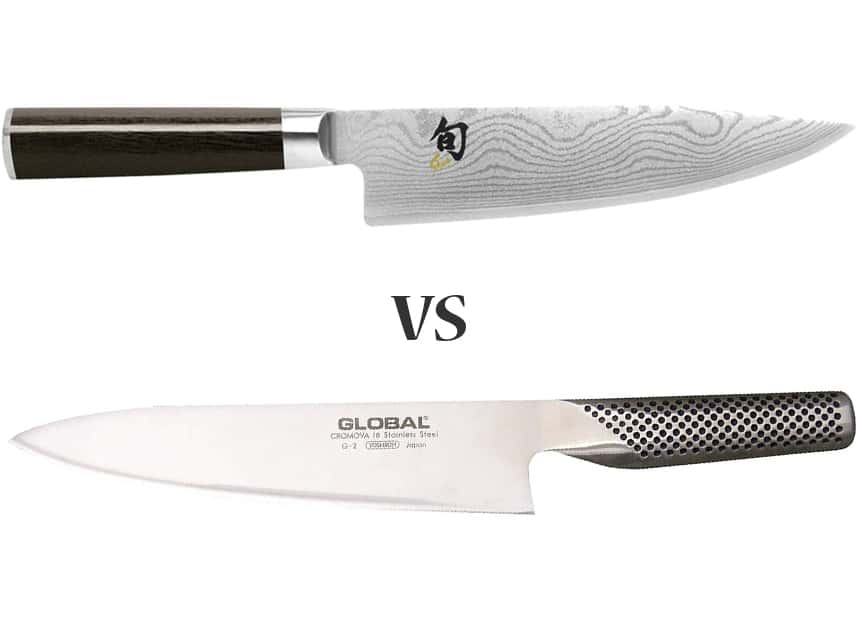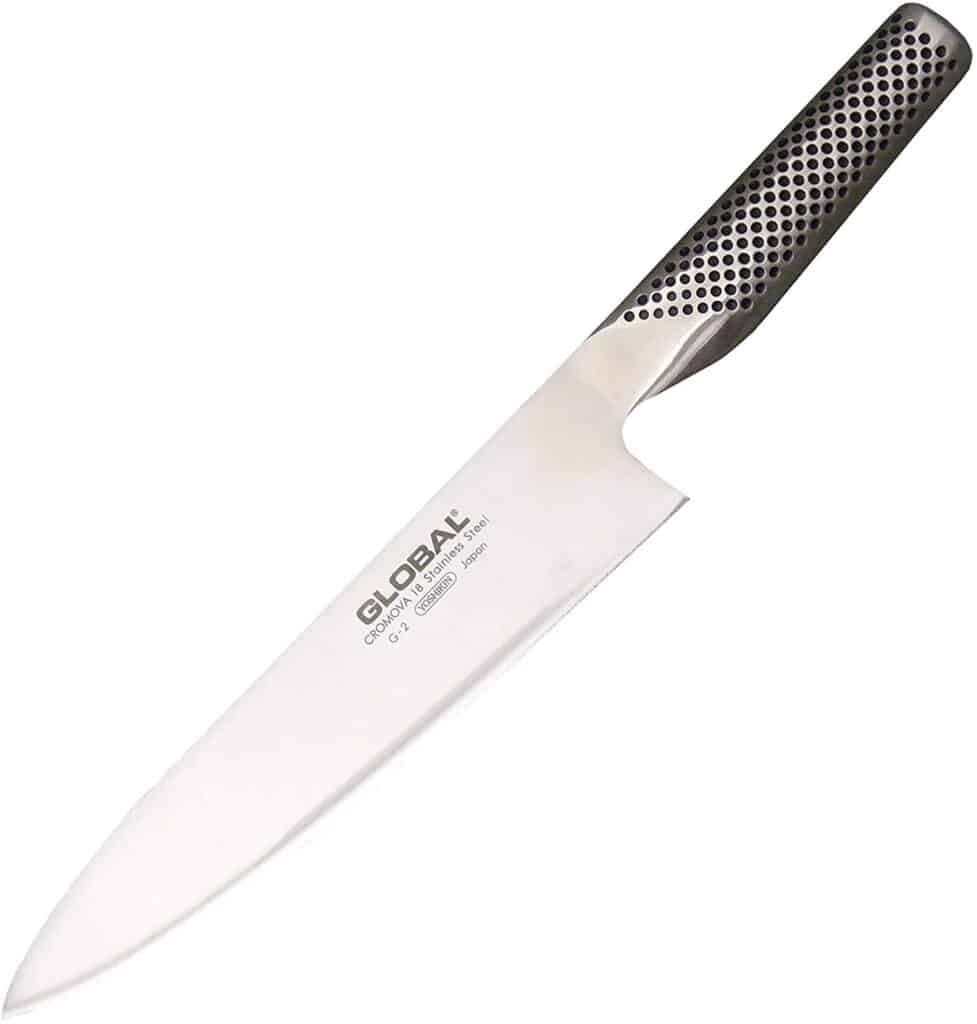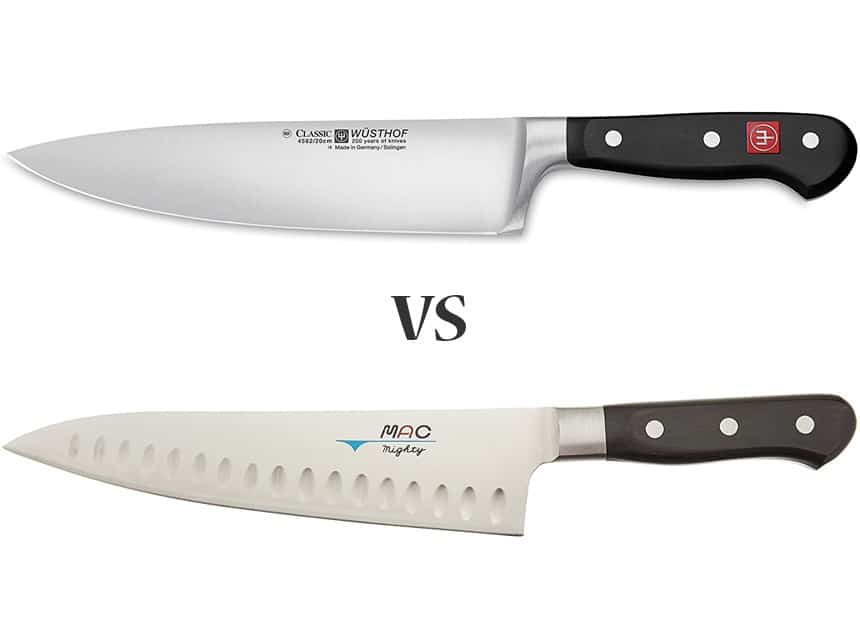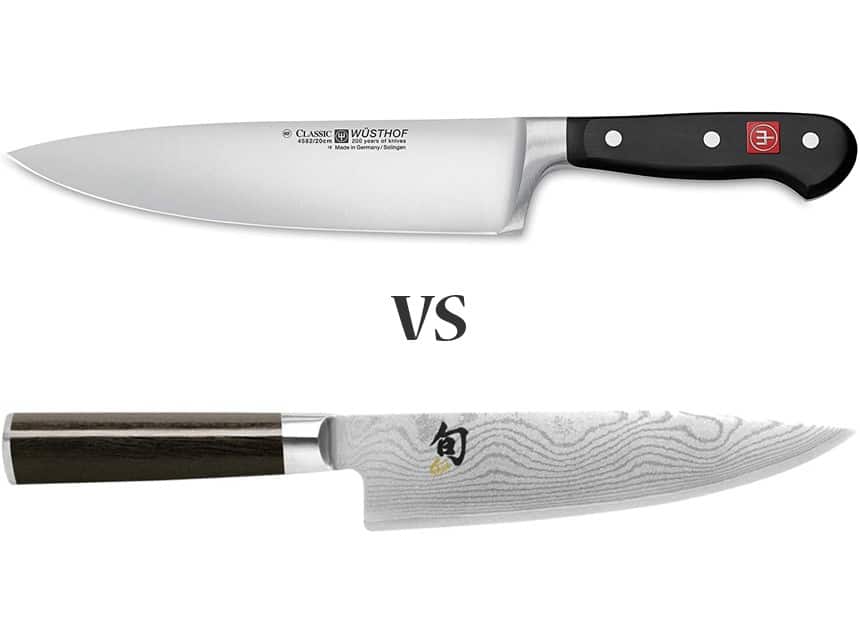
Japanese knives are increasing in popularity, and it’s easy to see why.
They offer innovative designs that are quite different from traditional western chef’s knives. Two of the best Japanese brands are Shun and Global and as a result, people are often deciding between the two.
In this article, I’m going to tell you the differences between these two great brands. I’ll go in-depth into the details of each, talking about where they are made, what materials are used and the difference in price.
This should be all the information you need to select your perfect knife.
Shun knives offer a far superior, sharper cutting edge but Global knives are much more durable and lightweight making them well suited to busy family kitchens.
| My recommendation | Current price |
| Shun Classic 8-Inch | View on Amazon (opens new tab) |
| Global Classic 8-Inch | View on Amazon (opens new tab) |
Shun vs Global – Comparison Table
Here is my summary comparison table for each brand. This is mostly based on their main range of knives; the Shun Classic and the Global Classic (G Series) Chef’s knife.
For a more in-depth look at each category then check out the rest of the article below.
| Category | Shun | Global |
| Country of Manufacture | Japan | Japan |
| Steel type | VG-MAX | Chromova18 |
| Rockwell hardness | HRC 61 | HRC 56-58 |
| Factory edge | 16 degrees (double bevel) | 15 degrees (double bevel) |
| Handle material | Pakkawood (wood/resin composite) | Steel |
| Price range | $160 – $180 (Classic) | $150 – $170 (Classic/G Series) |
| Main benefit | Sharper with better edge retention | Very durable, lightweight and slim |
| My recommendation | Shun 8-Inch Classic (view on Amazon) | Global 8-Inch Classic (view on Amazon) |
Shun vs Global – Where are they made
| Brand | Country of manufacture |
| Shun | Japan |
| Global | Japan |
All Shun knives are manufactured in the Japanese city of Seki. Seki is known as the knife capital of Japan, with a population of only 90,000 it lies around 150 miles from Toyoko but is the central hub for all of Japan’s major knife manufacturers.
Shun knives are designed with a Japanese influence but to suit the demands of the Western market, with a larger focus on durability compared with other Japanese brands.
Global knives are manufactured in the city of Niigata, on the North-Western coast of Japan.
Niigata is where the Yoshikin metal manufacturing company has been based since 1954, so they have a good span of heritage making Japanese steels.
Both of these brands produce their knives in the homeland of their heritage, an added bonus for anyone looking for a genuine Japanese knife.
Shun vs Global – What steel do they use
Knowing which steel a knife is made of is one of the most important things to understand when buying a knife.
The steel used will give you a very good indication of what the manufacturer has focused on as the most important aspect of the knife, such as durability or sharpness.
| Brand | Steel type | Rockwell hardness |
| Shun Classic | VG-MAX | HRC 61 |
| Global | Chromova18 | HRC 56 – 58 |
The Shun Classic range uses their own Japanese steel VG-MAX. Not all Shun knives are made from VG-MAX, it’s their own specially formulated steel with the aim of VG-MAX being an improvement on the (already very good) VG-10 steel.
VG-MAX is a fantastic steel. It’s been made with a Japanese influence in mind but also with a strong focus on appealing Western markets.
That means it’s got a fantastic balance between strength and durability.
We can see why when we look at VG-MAX’s levels of Carbon, Vanadium and Chromium.
This is a high-Carbon steel, with a Carbon content of 1.1%. Often, such a high Carbon steel will be more prone to chips in the blade. As materials become harder they usually become more brittle; however, that’s not quite the case for VG-MAX.
To understand why we’ll look at the Vanadium content first. For a high Carbon knife it’s pretty high at 0.3%.
As a result VG-MAX is more resistant to wear than most other high Carbon steels.
The Chromium content is a very hefty 16%. That makes VG-MAX one of the best stainless steel on the market at resisting rust.
Those two factors make this a very durable high Carbon steel.
Global knives are made from their own specially formulated steel, Chromova18.
You’ll only find Chromova18 in Global knives and it’s a very unique steel. To understand why let’s look at some of its Chromium content.
The 18 in Chromova18, represents the steel’s Chromium content, which is 18%. That is a huge level of Chromium by any standard and it’s an amount you’ll rarely see in another knife.
That means that Global knives are especially resistant to rust, making them particularly durable. That’s really the theme of Global knives, they are Japanese knives but they have a focus on durability.
The Carbon content is quite high at 0.75 – 1.05%. Usually, that would lead to a very hard knife, which could hold a super-sharp Japanese style edge, but that’s not the case with Global.
The rather unique composition of Chromova18 actually results in a rather soft steel, with a Rockwell hardness between 56-58 HRC.
I don’t regard this as a bad thing though, it plays directly to the strengths that the brand wants from their knives; durability over sharpness.
A softer steel is less likely to chip and snap, and it’s easier to sharpen (although you would need to sharpen it more often).
Combine that with the 18% Chromium content and this is a knife that will last a very long time.
That big difference in hardness is clear when we look at the comparative Rockwell Hardness (HRC).
The Shun Classic knives have a much higher HRC than the Global, standing at 61 compared with 56 – 58.
As a result Shun knives will hold their sharp edge for much longer than a Global can.
Shun vs Global – How sharp are they
Once again I’m going to focus on the most popular knives from each brand for this comparison.
You will experience a sharper edge using Shun knives than Global knives due to the steel of the Shun knives being much harder.
| Brand | Factory edge | Rockwell hardness |
| Shun Classic | 16 degrees (double bevel) | HRC 61 |
| Global | 15 degrees (double bevel with straighter edge) | HRC 56-58 |
Sharpness is vital when looking for a knife, but in this case, there’s a bit more to it than just looking at which knife has the smallest angle of its edge.
Usually, the smaller the angle the sharper the blade. However, there are other considerations that are particularly important when comparing these two knives.
Harder knives will hold a sharper edge for longer. The Shun uses much harder steel than the Global.
So, even though Global knives are made with a similar factory edge of 15 degrees, the Shun knife will actually hold its edge for much longer.
Global knives have a very long bevel design, with the bevel remaining very straight up the knife.
That makes it sharper than other knives of similar hardness, where the bevel is usually focused on the last 1-2 mm of the knife blade, but it still can’t compare with the Shun over time.
Shun vs Global – What are the handles made from
The material used for handles is a vital and often overlooked feature of any knife.
A quality handle is often the sign of a quality overall knife. Handles need to be made from a durable material that can withstand all the heat and moisture fluctuations knives can experience in the kitchen.
| Brand | Handle material |
| Shun Classic | Pakkawood (wood/resin composite) |
| Global | Chromova18 steel |
Shun use a wood/resin composite called Pakkawood for their knife handles.
Pakkawood is extremely common in knife handles for quality Japanese knives, although many non-Japanese knife manufacturers around the world have begun to use it as well.
Pakkawood is a great material for knife handles, it’s more dense and durable than real timber. That means it’s more resistant to wear and tear and won’t crack over time as timber handles might.
The versatility of design also makes it a popular choice, it can be dyed all sorts of colors and will often give the appearance of a true wood finish.
Pakkawood is very resilient to temperature and moisture changes and makes a terrific material of choice, it also adds to the Japanese influence of the knife with Pakkawood being a popular Japanese knife handle material.
Global knives use their own steel, Chromova18 to create the handle, and form the whole knife out of a seemingly single piece of steel.
Technically the knife isn’t made from one piece of steel. The blade is made in one piece. The handle is made from a further two pieces, the handle is hollow and filled with sand in order to offer the perfect counterbalance weight to the blade.
All the pieces are then welded together to form a seamless knife, with the blade and handle becoming one.
It’s a fantastic design and results in the most durable handle you’ll find in any knife, it’s basically impossible to damage this handle unless you were pretty determined to.
As the stainless steel on its own would be difficult to grip, Global handles are always dimpled to provide extra friction. It’s a technique that works well and for home use, providing the cook with plenty of control over the knife.
Global handles are near indestructible and contribute drastically to the lightweight design of Global knives due to the hollowed handle.
Both the Pakkawood and continuous steel are fantastic handle options, you won’t be able to damage a Global handle in normal use, and it’ll be pretty hard to damage a Shun handle too.
But for pure indestructibility, Global wins.
Shun vs Global – How much do they cost
Both these brands have wide ranges of knives all at differing price ranges.
To allow for a fairer comparison I’ve categorized three of their major ranges that represent their highest and lowest cost knives.
I’ve tried to compare similar knives, sticking to 8 Inch Chef’s knives or the closest equivalent.
In brackets next to the general price range you’ll see the name of the range.
These prices are rough estimates. Prices do change over time but this is intended as a rough guide.
| Brand range | Shun | Global |
| Premium | $200 – $250 (Premier) | $200 – $250 (SAI) |
| Standard | $160 – $180 (Classic) | $150 – $170 (Classic/G Series) |
| Value | $80 – $100 (Sora) | No value range (although often discounted) |
The first thing to know is that Global doesn’t really have a ‘Value range’, their Classic range is about as low as they offer price-wise.
Overall both Shun and Global are priced quite similarly and so I don’t think the price difference is enough to make a distinction between these two brands.
However, there is one notable difference that might help you choose which is best for you, so let’s look at that next.
Shun vs Global – What is the difference
Now that we have looked at the design, materials, background and price of these brands we can fully understand the difference, and you should be able to make an informed decision on which knife is correct for you.
The main difference between Shun and Global knives is that Shun knives will hold a sharper edge longer. Global knives are more durable, slim and lightweight. There is also a clear design difference between the two.
| Brand | Main benefit |
| Shun | Sharper with better edge retention |
| Global | Very durable, lightweight and slim |
The Shun is the sharper blade. It’s a very high Carbon knife at 1.1% Carbon and has great edge retention.
The Shun is also remarkably durable for a high Carbon knife and is certainly one of the most durable Japanese knives available.
However, with its far harder steel in comparison with the Global, the Shun will also be more brittle and prone to chipping.
That’s fine if you are able to take care of the knife, it won’t chip very easily.
Whilst the Global’s steel can’t compete with the Shun on sharpness, it is the more durable of the two. It’s extremely rust resistant and less like to chip along the blade.
That’s important if you don’t want to worry too much about maintaining your knife.
The Global is also very slim and lightweight, making it ideal for cooks with smaller hands.
With that understood, it should now be easy to choose between the two knives.
Shun vs Global – Which is better for you
This is down to what you want from your kitchen knives.
For someone looking for an extremely sharp blade, the Shun is the obvious choice. But you do need to take more care to maintain it.
Caring for a Shun is not exactly hard, all you need to do is store it individually, such as in a knife block, using a blade sheath, or on a magnetic strip.
Essentially, you want to avoid knocking the blade edge against other hard objects when you’re not using it.
In busy family kitchens, where knives are likely to be thrown into the kitchen sink, cutlery drawer, or dishwasher without a second thought, this can be difficult.
But you’re aware of how to look after the blade, and just ensure it is properly stored after use, then the Shun will provide a superior cutting edge.
For a busy family kitchen, where multiple people might be using the knife or it’s a risk of being damaged or left soaking in water, then I would recommend the Global.
It’s more durable than the Shun and will require less care and attention.
It’s also lightweight and slim so can be easily used by a range of different sized people, often useful in a family kitchen.
As it’s a Japanese knife, the blade is still very sharp, it’s just not as sharp as the Shun.
My Shun Recommendation

View the 8-Inch Shun Classic on Amazon (opens new tab)
The Shun Classic 8-Inch is a superb knife and I’d highly recommend it.
The Shun Classic is an absolute masterpiece of merging Japanese and Western influences and I’d highly recommend it to anyone interested in quality knives that are a bit different.
I don’t think you could be disappointed with this knife.
My Global Recommendation

View the 8-Inch Global Classic on Amazon (opens new tab)
The Global Classic 8-Inch is one of the most durable knives you can find.
It’s made from a 18% Chromium stainless steel that is pretty much un-matched in the knife world.
But its biggest selling point is its size and weight. Global knives are very light and because they are entirely steel, the handle is actually hollow, with just some sand to counterbalance the blade.
It has no bolster and is slimmer than most knives, which makes it perfect for those who want a lighter, easier to control knife and is especially suited for people with smaller hands.
It’s a great knife, and one of a kind.

